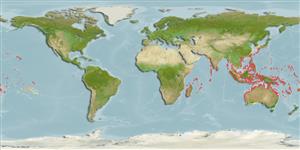Common names from other countries
>
Eupercaria/misc (Various families in series Eupercaria) >
Labridae (Wrasses) > Corinae
Etymology: Thalassoma: Greek, thalassa = the sea + Greek, soma = body; the colour of the sea (Ref. 45335).
More on author: Bleeker.
Environment: milieu / climate zone / depth range / distribution range
Écologie
marin récifal; profondeur 0 - 15 m (Ref. 1602), usually 1 - 15 m (Ref. 27115). Subtropical; 24°C - 28°C (Ref. 27115); 30°N - 32°S
Indo-Pacific: Somalia (Ref. 30573) and South Africa (Ref. 4392) to the Line, Marquesan, and Tuamoto islands, north to southern Japan, south to Rowley Shoals, northern New Zealand and Lord Howe and Rapa islands.
Taille / Poids / Âge
Maturity: Lm ? range ? - ? cm
Max length : 16.0 cm SL mâle / non sexé; (Ref. 9823)
Épines dorsales (Total) : 8; Rayons mous dorsaux (Total) : 13; Épines anales: 3; Rayons mous anaux: 10 - 11. Juveniles easily identified by the color pattern and rounded snout. Males become brightly colored and head usually green with a yellow band following on the body (Ref. 48636). Head naked, no scales dorsally on opercle. Initial phase with a broad blackish stripe from snout through eye to caudal-fin base (Ref 9823).
Occurs in aggregations over shallow lagoon and seaward reefs (Ref. 9710) and on reef flats (Ref. 9823). Feeds mainly on crustacean zooplankton (Ref. 1602). Spawns at dusk above reefs (Ref. 90102). Rarely marketed (Ref. 2334). Minimum depth reported taken from Ref. 128797.
Life cycle and mating behavior
Maturities | Reproduction | Spawnings | Egg(s) | Fecundities | Larves
Oviparous, distinct pairing during breeding (Ref. 205).
Randall, J.E., G.R. Allen and R.C. Steene, 1990. Fishes of the Great Barrier Reef and Coral Sea. University of Hawaii Press, Honolulu, Hawaii. 506 p. (Ref. 2334)
Statut dans la liste rouge de l'IUCN (Ref. 130435)
CITES (Ref. 128078)
Not Evaluated
Menace pour l'homme
Harmless
Utilisations par l'homme
Pêcheries: sans intérêt; Aquarium: Commercial
Outils
Articles particuliers
Télécharger en XML
Sources Internet
Estimates based on models
Preferred temperature (Ref.
115969): 24.8 - 29.3, mean 28.4 (based on 3194 cells).
Phylogenetic diversity index (Ref.
82804): PD
50 = 0.5000 [Uniqueness, from 0.5 = low to 2.0 = high].
Bayesian length-weight: a=0.00933 (0.00521 - 0.01670), b=3.07 (2.92 - 3.22), in cm Total Length, based on LWR estimates for this species & Genus-body shape (Ref.
93245).
Niveau trophique (Ref.
69278): 3.1 ±0.2 se; based on diet studies.
Résilience (Ref.
120179): Milieu, temps minimum de doublement de population : 1,4 à 4,4 années (Preliminary K or Fecundity.).
Fishing Vulnerability (Ref.
59153): Low vulnerability (10 of 100).
